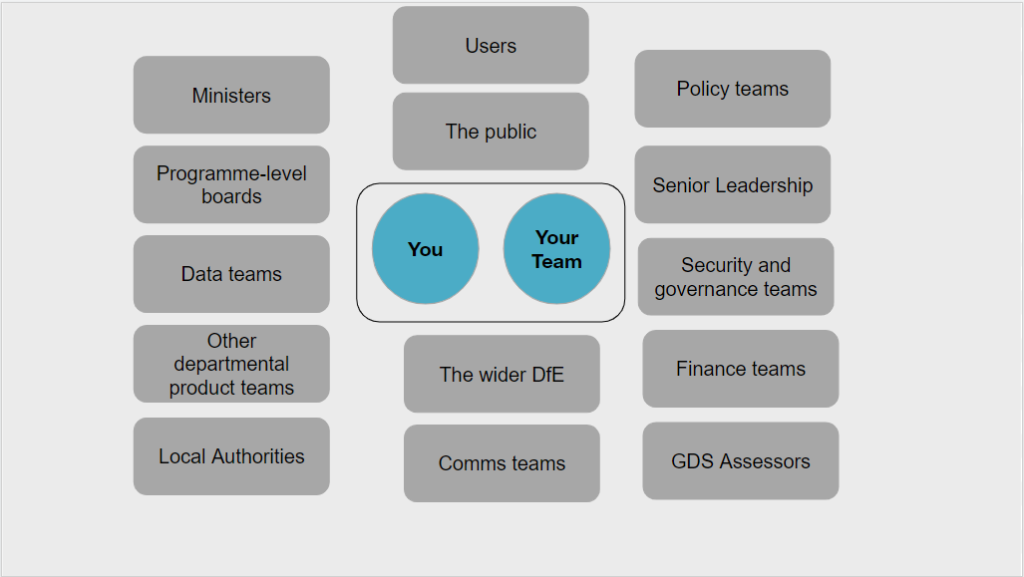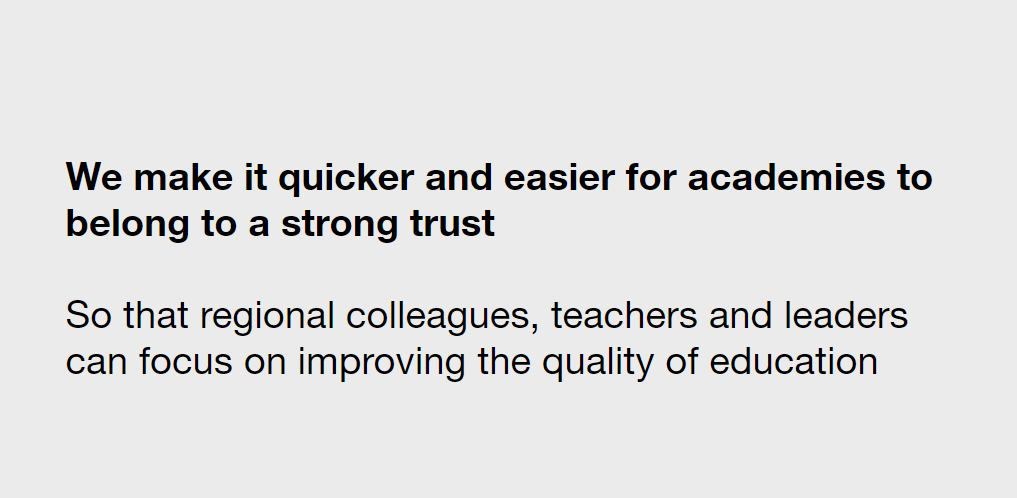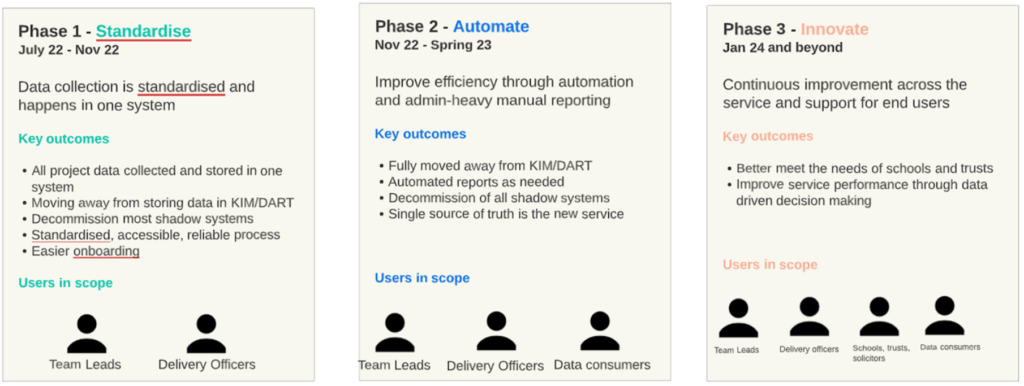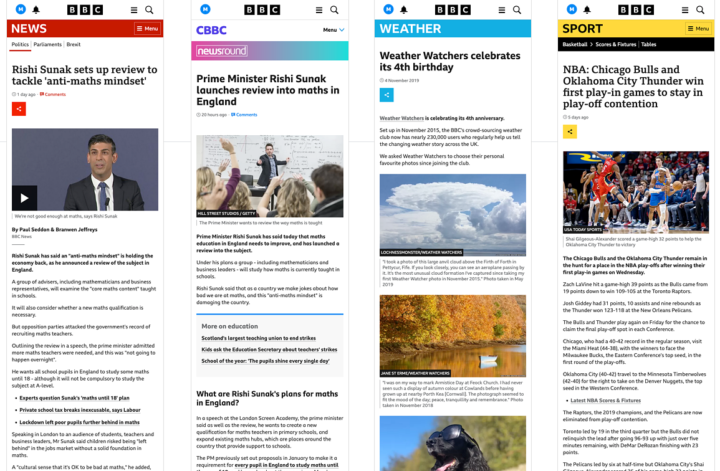Communication is a key skill in many roles but one that is essential to any product manager.
This post will explain why by looking at
- Why communication skills are a must-have weapon in any PM’s arsenal
- The benefits of good communication and the pitfalls of getting it wrong
- Some practical tips product managers can use to improve their communication skills
Why it’s a must for product managers to communicate well
Stakeholders, put simply, are everywhere.
What’s more they either expect to hear from us a lot, or alternatively, they don’t know about us but it’s vital that we get their attention for the benefit of our product.
This is why, whether we like it or not, communication is a key tenant to the product role.
To illustrate this point, I created a quick slide that shows all of the stakeholders I have to manage within my current role. As you can see, there are a lot of them.

What’s more, each of them have slightly different requirements from you.
Stakeholder groups are rarely alike, each will have their own unique needs owing to factors such as proximity to the work, investment in the success of your product, bandwidth or level of interest or expecation.
This means that often the user groups will require a different story about your product.
Quite often this means that as a product manager you have to tell the same story but in subtly different ways.
Below are examples of some of the stories you may be required to tell.
- Stories to tell your team to help them build an amazing product
- Stories to the executives and board to justify their investment and prioritisation of your product
- Stories to tell the rest of the organisation so you can collaborate and avoid duplication
- Stories to customers to inspire them to achieve great things.
Understanding your stakeholders and what kind of narrative they need from you (or more importantly you need to provide for them) requires a lot of thought and attention – not to mention different styles of communication both in terms of style and volume of comms.
Not doing the required level of planning and communicating will lead to you feeling swamped and isolated on your stakeholder-engulfed island.
What’s more, not managing these stakeholders through effective communication will lead to some really negative outcomes for you and your team
The pitfalls of poor communication
- The team will start to complain about a lack of direction, poor cohesion and confusion. This will lead to inertia, poor morale and slow progress.
- Stakeholders will start getting all up in your grill. Stakeholders, when left in the dark, tend to assume the worst. It’s human nature. This will mean that you can expect to start experiencing a lot of challenge and interference as they,understandably, try to get a handle on what’s going on in your team.
- Not communicated with other teams in your org will mean that interdependencies and opportunities will be missed. You may also be duplicating effort by working on the same thing as another team and missing the chance to collaborate.
- People don’t care about your product. Not communicating well, building interest and buy-in within your org will mean that nobody is rooting for your product and this isn’t good – especially when there are talks around budget and prioritisation.
- Users won’t find your product so there has been no point in all the hardwork This one is really important and something that I’ve sadly seem teams neglect to consider and wonder why user’s aren’t magically flocking to a product that no one has told them about by co-ordinating a marketing plan.
The benefits of getting communication right
- Your team feel unified, have a purpose, know what they’re doing and are excited about the task
- By communicating little and often with stakeholders you take them on the journey with you, they feel in the loop and assured and on the whole let you get on with things
- Mastering cross-team communications will mean that blockers, risks or opportunities can be mitigated for or pounced upon.
- It’s easier to share ideas o learn from others. And if I’m honest, what I really mean here is that may well be possible for you to steal ideas and sometimes even code from people that have walked the path before you
- You have a comms plans that has ensured your product is being used. Through short feedback loops you can iterate and improve upon each release.
Okay but how can I improve my communications?
“Be the person at the front telling everyone else about the plan”

This quote was offered to me by a product manager I was shadowing in my first product role at the Department for Education who told me it was the best piece of product advice he’d ever been given.
I didn’t get it at first but I do now and I agree with him, this advice is probably my go to communications strategy.
For anyone else that is as baffled as I was when I first heard it, let me try to break it down.
This quote isn’t saying that you you need to be the person with all the answers, but if you don’t go to stakeholders with a narrative about your product, other people, normally stakeholders, start shaping it for you.
Therefore, your job is to be on the frontfoot by going out to stakeholders with an outline of your plan. Even if it is incomplete, take it out to stakeholders and let them know what you’re thinking.
The beauty of this approach is that you don’t have to have the answers, or commit yourself to a plan. You can frame it in a way that says ‘right now, this is our current thinking, what do you think?’
This opens up a space for stakeholders to either feed into your plan, or give you some extra knowledge or things to look into, or, possibly give you their thinking as to why this plan won’t work’.
All of which are good outcomes that, unless you’re on the front foot communicating effectively, you will miss out on.
This approach also also puts stakeholders at ease. They can see and help to shape your thinking. The alternative is that, not feeling they’re the information will start assuming the worst and will enter the space often dictating what they think needs to happen.
If you want to be in charge of your product’s destiny, make sure you’re leading the charge instead of them by communicating well.’
Use storytelling

In order to create your product’s narrative, you need to become it’s key storyteller-in-chief.
As this picture shows, without good storytelling, everything is jumbled up, messy, people can make little sense of what you’re trying to tell them.
With good storytelling then everything can seem obvious. I saw a tweet once (which I’d credit if I could remember who by) that said ‘if you get to a point in which stakeholders agree with the approach you’re suggesting because it seems like the most common-sense decision, then you’ve got your storytelling right.”
That really resonated with me. Your job as a product manager is to bring clarity to what can often be really complex problems – a hard task that requires a lot of skill and effort.
What tools can we use to tell better stories about our product?
Create a product vision
A product vision gives your product a purpose – without a purpose there is no story.

Without sharing the drama the main character (our end users) is facing, the audience (your team / stakehholders) don’t empathize with them enough to go the extra mile and solve their problem. Taking the time to craft an inspiring and clear vision with your team will help you to set out what we’re trying to do, who we’re doing it for, why you’re all bothering to work so hard to do it.
Having a vision will also help you to bring people back on track when your team goes off in tangents as you can use it to remimd people about the shared goal you’re working towards and prevent the team exploring unhelpful territories.
Embrace visual thinking
Explaining your point using visual tools is a key that will open many doors, especially when you’re trying to communicate complex points. Having a chart, diagram, or an artifact like a roadmap can make getting difficult points across so much easier
Here’s an example of a piece of visual thinking I’ve used in the past to help communicate a product strategy within a previous team.

The context doesn’t really matter and as you can see I’m not the world’s greatest artist.
However by simply using shapes, icons and formatting alongside some bold phase names our team was able to effectively convey our strategic approach in a manner that was visually digestible.
Having this simple three step diagram enabled our team to illustrate the path we wished to forge to our senior stakeholders whilst inviting them in to comment on our plan, amend it or add any context we might have. A meaningful conversation was had, one that would have felt waffly and jumbled without a visual asset to focus the conversation around
Plotting your outcomes
This last tip is another one a senior colleague at the DfE shared with me. It’s so simple but effective it feels like a videgame cheat code.
Plan your outcomes
Put short, everyone’s time is precious – so, before every important meeting or call with whatever stakeholder or team mate you’re hoping to influence, you should imagine what the desired outcome is you’d like to arrive at by the end of the interaction.
If you know that you need them to make a decision, help you understand something, or get them to unblock something, knowing what you need from the conversation can help you to prepare in advance to make sure that you can communicate in the most effective way by having a plan for the key points need to hit to drive the conversation where you need it to go.
If you’ve enjoyed this article or found it helpful, please feel free to either comment below, share it on social media or reach out with any thoughts or questions on social media.



